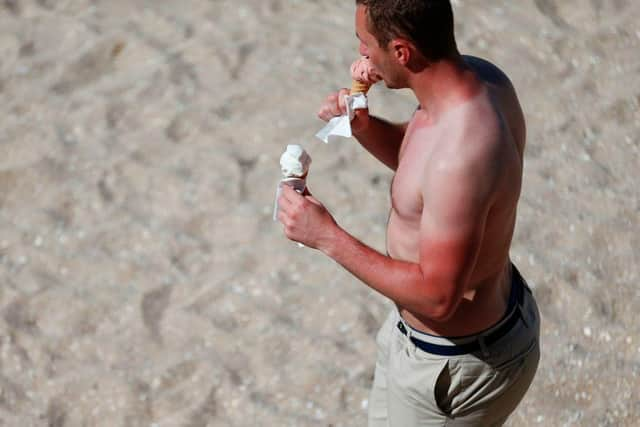5 best treatments for sunburn: how to soothe and heal sunburned skin - and how long symptoms last
and live on Freeview channel 276
As the weather across the UK starts to become sunny and dry following an uncharacteristically rainy May, some of us may fall victim to sunburn.
It’s important to stay safe whilst out in the sun, as sunburn increases your risk of skin cancer - but if it’s already too late and the damage has been done, there are ways you can treat your sunburn at home.
Advertisement
Hide AdAdvertisement
Hide AdThe Skin Cancer Foundation recommends the following advice.


Cool your skin down
You should act fast to cool the sunburn down as your very first step. Cool your skin using a cold compress - you can use ice to make ice water for a cold compress, but don’t apply ice directly to the burnt skin.
Alternatively, you can take a cool shower or bath, but not for too long as this can be quite drying. You should also avoid harsh soaps, which might irritate your skin even more.
Moisturise
While your skin is damp, moisturise using a gentle moisturising lotion - but make sure it’s not petroleum or oil based, as this can trap in the heat and make your burn worse.
Advertisement
Hide AdAdvertisement
Hide AdContinue to moisturise to keep burn or peeling skin hydrated over the next few days.
We want to hear from you: let us know what you think about this story and be part of the debate in our comments section below
Reduce inflammation
To tackle pain or inflammation, you should take a nonsteroidal anti-inflammatory drug (NSAID), such as ibuprofen.
You can also use an over the counter one per cent cortisone cream as directed for a few days to help with the redness and swelling. Aloe vera can also help to soothe mild burns.
Advertisement
Hide AdAdvertisement
Hide AdStay hydrated
Burns draw fluids to the skin’s surface, and away from the rest of the body, meaning you can become dehydrated. It’s important to stay hydrated whilst your skin heals by drinking extra liquids, such as water and sports drinks that help replenish electrolytes.
Keep out of the sun
You should take extra care not to expose sunburned skin to sunlight until the skin has fully healed.
Avoid all sunlight, including through windows, and cover up the affected area until the skin has healed.
What should I avoid doing?
- Do not use petroleum jelly on sunburned skin
- Do not put ice or ice packs on sunburned skin
- Do not pop any blisters
- Do not scratch or try to remove peeling skin
- Do not wear tight fitting clothes over sunburned skin
How can I stop from getting sunburned?
To help protect your skin from getting burnt, you should use sunscreen. When buying sunscreen, make sure that the label has a sun protection factor (SPF) or at least 30 to protect against UVB, and at least a four star UVA protection.
Advertisement
Hide AdAdvertisement
Hide AdIf you already have sunscreen at home, make sure that it hasn’t expired - most sunscreens have a shelf life of two to three years.
Most people do not use enough sunscreen - as a guide, adults should aim to use around two teaspoons of sunscreen if you’re just covering your head, arms and neck, and around two tablespoons of sunscreen if you’re covering your entire body.
If sunscreen is applied too thinly, the amount of protection it offers is reduced.
You shouldn’t rely on sunscreen alone to protect yourself - the NHS also recommends spending time in the shade between 11am and 3pm and covering up with suitable clothing, like a wide-brimmed hat and long-sleeved top.
Advertisement
Hide AdAdvertisement
Hide AdHow long does it take sunburn to heal?
According to the NHS, the skin will usually start to flake and peel after a few days, and will generally be fully healed within seven days.
You should see your GP or call NHS 111 if any of the following occur:
- Your skin has blistered, or become swollen
- You have a very high temperature, or you feel hot and shivery
- You feel tired, dizzy and sick
- You have a headache and muscle cramps
- Your baby or young child has sunburn
Comment Guidelines
National World encourages reader discussion on our stories. User feedback, insights and back-and-forth exchanges add a rich layer of context to reporting. Please review our Community Guidelines before commenting.
